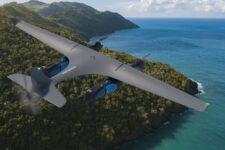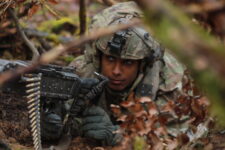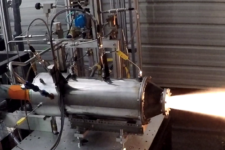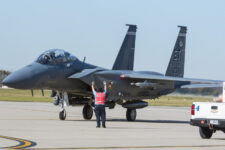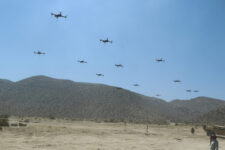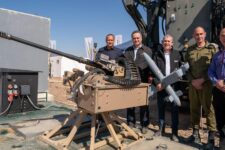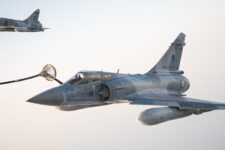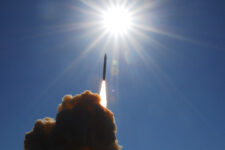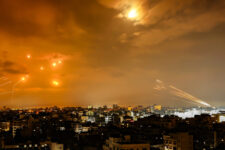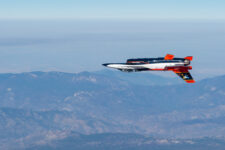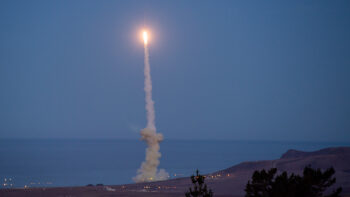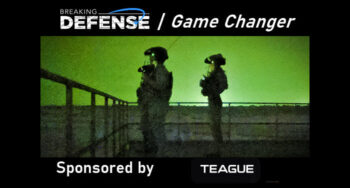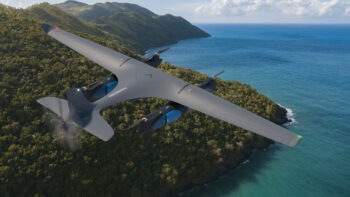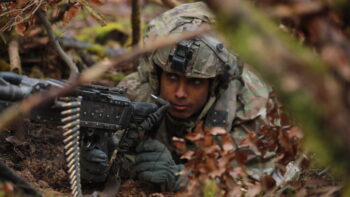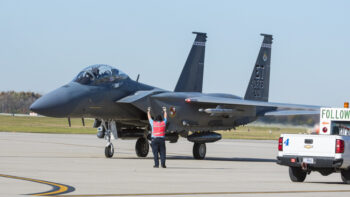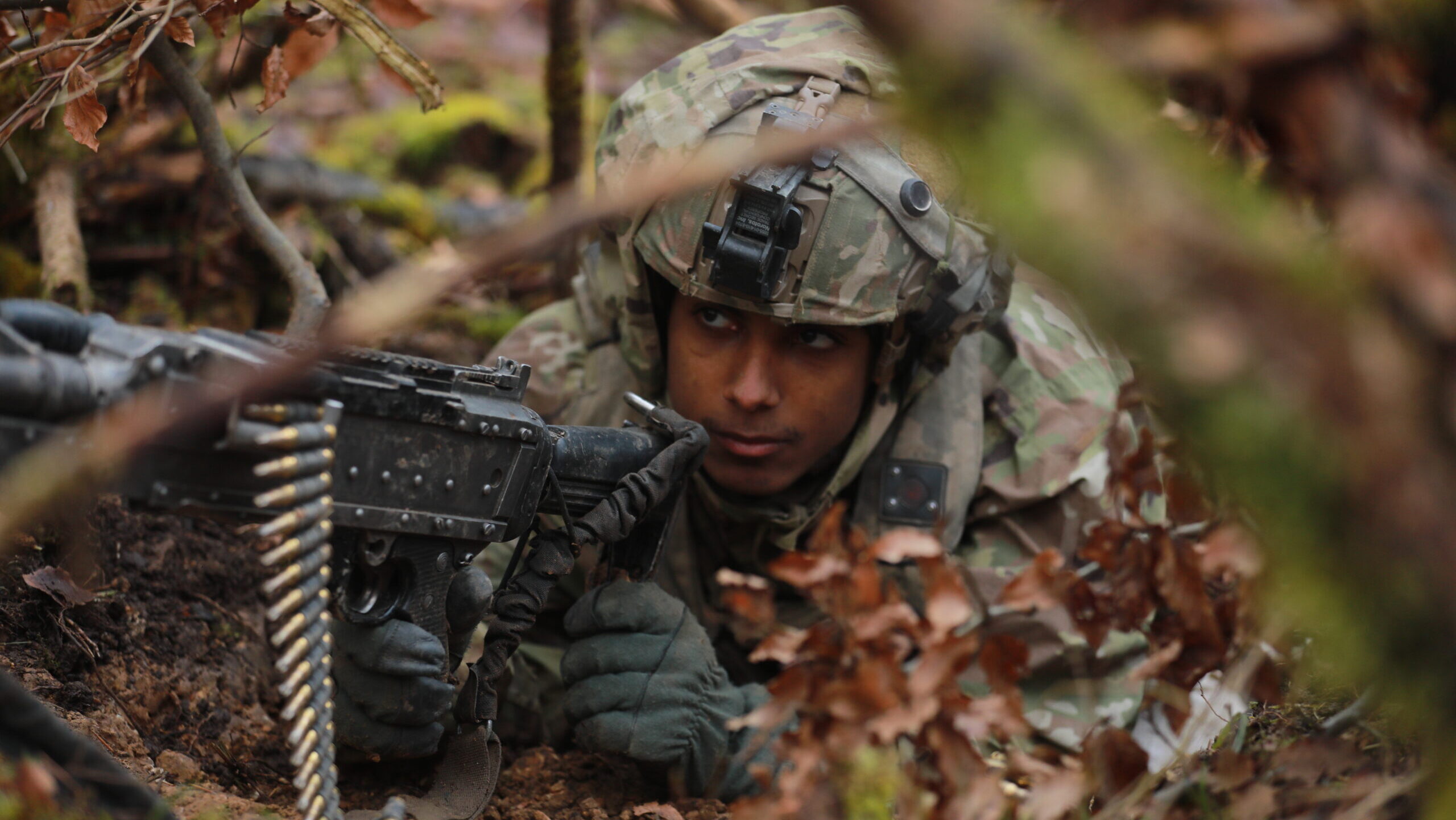
US Army Pvt. Miguel Garcia, a cannon crewmember with 5-25 Charlie Battery, 3rd Brigade, 10th Mountain Division, utilizes cover and concealment to safeguard the area of operation at the Joint Multinational Readiness Center in Hohenfels, Germany, Jan. 31, 2025. (US Army Reserve/Staff Sgt. Tristan Peete)
WASHINGTON — Freezing fog and chilling rain put new US Army drones and tech to a wintery test when soldiers with the 3rd Light Brigade Combat Team, 10th Mountain Division headed to Germany for a key exercise, according to a trio of Army officials.
As part of Army Chief of Staff Gen. Randy George’s effort to test new formations and push technology to the force more quickly, last year he tasked three infantry units with testing out new equipment in different climates under the “transformation in contact” (TiC) 1.0 banner. The 2nd Brigade Combat Team of the 101st Airborne Division headed to the swamps in Ft. Johnson, La. while the 2nd Light Brigade Combat Brigade of the 25th Infantry Division was out in Hawaii.
Soldiers from 3-10 Mountain Division got tasked with the cold, and towards the end of their nine-month stint in Europe, capped off TiC 1.0 testing as part of the Combined Resolve exercise at the Joint Multinational Readiness Center in Hohenfels, Germany.
“This is bottom-up innovation from our troops on how we need to change how we train and operate, how we change how we’re organized. And it has informed a lot on how we buy things and really what we buy,” George, just back from Europe, told reporters Wednesday in the Pentagon.
“It was very icy, very cold, very wet…but that’s exactly what we wanted to do. We wanted to exercise things and all different types of terrain,” the four-star general added.
Smaller drones had battery problems while larger quadcopters had to be grounded when freezing fog covered the hills. Soldiers were fans of the newer Infantry Squad Vehicles while the robotic mule got mixed reviews.
The plan now, George said, is to use those findings from the three TiC units to make investment and fielding decisions, and tweak infantry formations.
Striking out
When soldiers with the 3-10 Mountain Division, headed to Europe for a rotation in July 2024, they did so with a host of the TiC 1.0 tech and weapons including new drones, loitering munitions, ground vehicles, and a “minimal viable” version of the Command and Control (C2) Fix, commander Col. Joshua Glonek told Breaking Defense during a Feb. 8 interview.
“Throughout the course of the deployment, my brigade has been arrayed along NATO’s eastern flank, really, from the Baltics up in Estonia all the way down to the Black Sea region in Romania,” Glonek said. “To be able to field this equipment dispersed all throughout Eastern Europe, we had to get the requisite agreements with all the countries we were in to start flying these drones and operating the equipment in their training areas.”
Getting those approvals was a major time suck, Glonek said, but he believes having done it once means future units will have an easier time navigating the bureaucratic process. And with approvals in place, the unit reorganized to spread sensors and shooters throughout the formation.
“What we’re trying to do is to shorten the kill chain and reduce the time it takes from identifying an enemy force to acting on it, whether that be through lethal fires or sort of effects that we’re trying to achieve,” Glonek said.
For the 3-10 Mountain Division, it opted to create three identical “strike” companies with 80 soldiers in each — one for each of the formation’s three infantry battalions.
Within each strike company, Glonek explained, there is a scout platoon, mortar platoon and a lethal unmanned system platoon. The latter included smaller squads to fly drones, loitering munitions and systems to take down incoming aerial drones. Electronic warfare teams were also integrated into the formation.
“The strike company is designed to be the lead echelon of the battalion, which combines manned and unmanned sensors in order to make contact with the enemy and to attrit enemy forces before they come in the range of our traditional infantry companies,” Glonek explained.
So how did the new equipment perform?
Drones: Lessons In Weather
Across the formation, 144 new and experimental drones were given to soldiers to test out, with mixed results. At the company level and below, they used Skydio’s RQ-28A quadcopter, and the C-100 multi-mission quadcopter from Performance Drone Works.
One clear lesson: “We were seeing [a] very, very reduced battery capacity, which were limiting the amount of time we could fly those short-range drones,” Glonek said. “For the medium- and the long-range drones, those really weren’t affected that much by the cold weather in terms of their battery life.”
Alex Miller, the Army Chief’s Chief Technology Officer, told reporters on Tuesday that in the freezing climate the RQ-28A experienced battery challenges. Although soldiers had been able to fly that Skydio drone for up to 20 minutes in warmer test events, in the German winter they would only stay up in the air for four-to-five minutes.
“Either you carry a lot more batteries, which are heavy, or we figure out better ways to get more out of…the batteries that we will have,” Miller said. Soldiers with 3-10 altered how they used the drones to maximize those five minutes, he noted, without going into detail on what that looked like.
The lessons learned will help feed into future requirements for smaller drones, Miller indicated.
The C-100 — a man-packable quadcopter designed to ferry up to 15 pounds, for missions up to 74 minutes— is one of two drones the service recently selected for its medium-range reconnaissance line. While the second one, Anduril’s Ghost X, was also in the field but with the 3-10 Mountain Division opted to use them differently.
The C-100 “performed relatively well” and was used more for close-in-reconnaissance missions since it has a shorter range, Glonek explained. His soldiers then used the Ghost X for targeting and directing artillery, mortars and loitering munitions towards targets.
While the commander called the Ghost X quadcopter a “very effective system” when the weather dropped below the freezing point, soldiers had to ground it.
“What frequently happens at the [Joint Multinational Readiness Center] is the fog sets in, you sort of get freezing fog,” Glonek said. “Just like any aircraft, you get icing on the blades or the propellers, and you’re limited in the ability to fly. So there were times where we couldn’t get the aircraft up because of how adverse the weather conditions were.”
While Miller did not specifically discuss the Ghost X with reporters, he said one option for cases like that is to coat them in anti-freeze spray on the drone and “accept that there’s a little bit of risk there.”
Interestingly, Glonek said that two unnamed vendors for the possible upcoming Long-Range Reconnaissance drones competition also joined soldiers out in Germany. While Glonek said his brigade was not there to evaluate the competitors, they were able to provide feedback on how such a weapon could be used on the battlefield.
Such a drone, he explained, provided his soldiers with a greater standoff distance. During a nighttime operation, for example, the LRRs flew 10 km ahead of his frontline to detect the opposition force, enabling soldiers to call for artillery fire and strike 50 percent of the spotted opposition force before it left the assembly area.
“The Ghost X is really good for our strike companies … providing observation within range of their organic systems,” Glonek said. “But at the brigade level, I need to look much deeper, because I’m trying to identify enemy formations before they get within range of the battalion.”
Ground Vehicles: Real World Scenarios
Not all the weapons and new tech tested out were relegated to the air. Two GM Defense- developed Next Generation Tactical Vehicle-Hybrid, or NGTV-H, were also out at the event. Soldiers used those two vehicles as part of the more mobile brigade tactical command post, and were able to operate them for 72-hours before refueling.
There were also 96 of GM’s Infantry Squad Vehicles (ISV), at the event and the formation was tasked with helping the Army decide how many vehicles should be fielded to formations. The feedback, Glonek said, was that all infantry formations should receive the vehicle since it provides “exceptional mobility.”
“The ISV is a mobility platform, not a fighting vehicle, and if you make contact with the enemy at an ISV, that is more than likely going to result in a lot of friendly casualties,” Glonek added. “We spent a lot of time talking about the need to dismount in the right locations, so that by the time you made contact with the enemy, you were dismounted, spread out in a combat maneuver formation, not fully mounted on ISVs.”
Soldiers with 3-10 also tested out the Army’s new robotic mule dubbed the Small Multipurpose Equipment Transport (S-MET), produced by General Dynamics Land Systems. They primarily loaded the ground vehicles up with ammunition and anti-tank weapons, and then moved through the woods with the S-METs trailing behind. By and large, the feedback was positive, but there were times when rough terrain forced soldiers to deviate from their planned route.
“We used it all the way to the front lines, and some of the feedback was, there’s probably some situations where we wouldn’t do that again, just because we’re trying to stay in very covered and concealed routes,” Glonek added. “We don’t want to have to change our route up to accommodate areas where the S-MET can or can’t go.”
As for the road ahead, TiC 1.0 feedback from the 3-10 Mountain Division will be added to feedback from the other two units, and there should be forthcoming formations and acquisition decisions on the horizon, the Army Chief said.
Additionally, the service is moving out with plans for TiC 2.0 this year focused on expanding the initiative to two armored brigade combat teams, two Stryker brigade combat teams, and other units in the Guard and Reserves. While details are still being sorted out, Miller said there will be a focus on sustainment, automation and ground autonomy.
